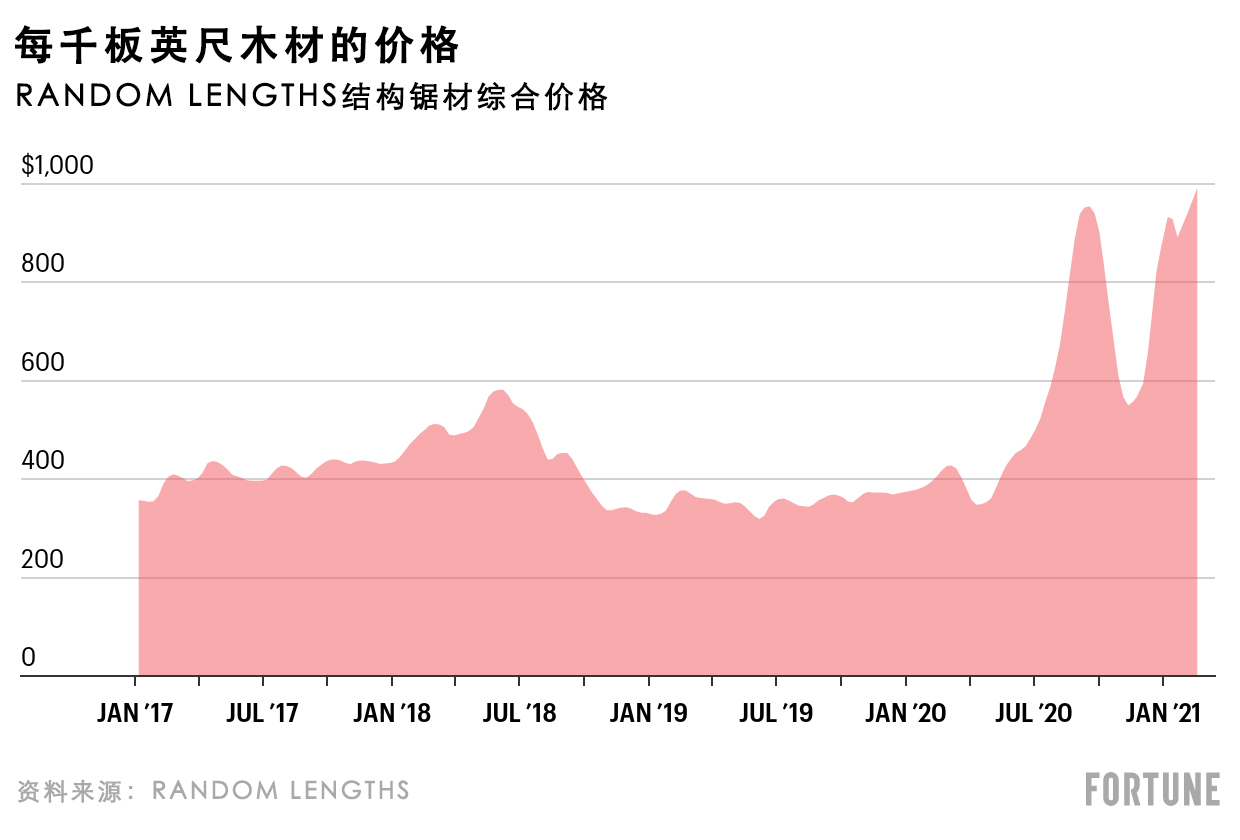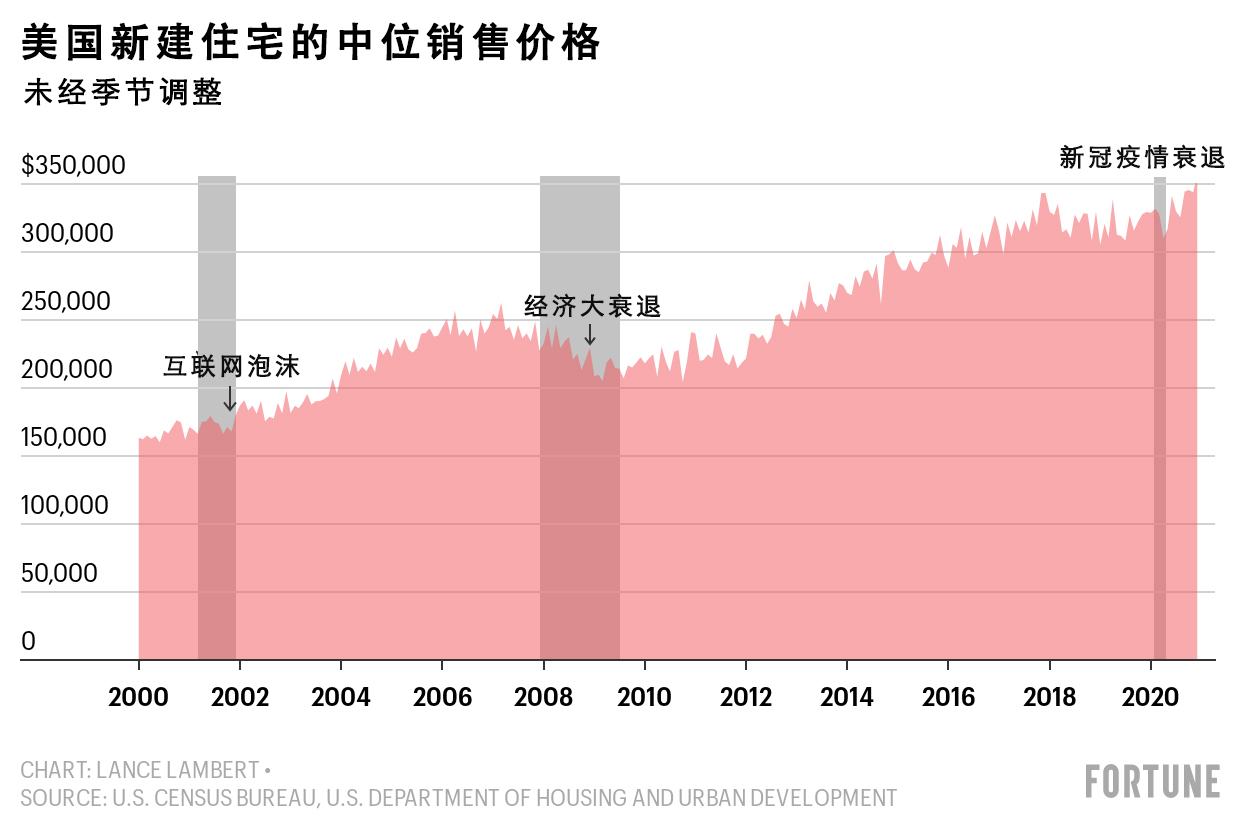因这一原材料短缺,美国房价飙升
人们经常说,房屋装修需要付出的时间和成本往往会超出预算一倍。但这种说法现在可能有些乐观,原因是最近木材价格暴涨。
早在2020年8月,《财富》杂志就发表过一篇文章,分析了新冠疫情导致木材需求激增和供应量下降的情况。疫情带来的巨大冲击使木材价格暴涨134%。美国房屋建筑商协会(National Association of Home Builders)表示,木材价格上涨将使一栋普通新建独栋住宅的施工成本增加约14,000美元。
不过分析师曾经认为木材价格很快会有所回落,但他们的预测并未成真。
相反,木材价格进一步上涨。据Random Lengths统计,截至2月18日,每千板英尺木材的价格为992美元。木材价格自疫情爆发至今上涨了180%。根据美国房屋建筑商协会的计算,按照当前的木材价格,一栋普通新建独栋住宅的价格将上涨24,000美元。
到底发生了什么?2020年春季,在各州发布封锁命令之后,美国各地的锯木厂纷纷停工,导致木材供应量锐减。与此同时,居家隔离的美国民众意识到,这是进行房屋装修或做手工项目的绝佳机会。于是,木材需求激增。
2020年秋季,木材价格开始下跌,在11月初降至每千板英尺550美元。似乎木材价格已经开始回落。然而,美国在2020年最后几周新冠肺炎确诊病例激增,降低了锯木厂的生产速度,尤其是在备受追捧的加州红木产区。这种状况再次导致木材价格飙升。

不要把问题只归咎于劳氏公司(Lowe's)和家得宝(Home Depot)的顾客:在疫情期间,新房建设行业异常繁荣,也加剧了木材短缺问题。事实上,2020年12月,美国新住宅开工量创下14年新高。
众所周知,在2008年金融危机及随后几年,住宅市场崩溃,房屋建筑量直线下降。那么,此轮繁荣的原因何在?首先,住宅并非本次危机的驱动因素。其次,利率接近历史最低水平。第三,1989年至1993年出生的大量千禧一代,将在2019年至2023年期间步入30岁,这五年被认为会出现购房高峰。
另外一个限制供应量的因素是,许多美国老年人选择等到疫情结束之后卖房,导致现有房屋存量下降,因此更多购房人选择了新建住宅。房价也随之出现波动:自疫情爆发以来,美国新建住宅的中位销售价格已经上涨了27,700美元,达到355,900美元。

高居不下的木材价格是否会成为新常态?Fastmarkets RISI公司的高级经济学家达斯汀·贾尔伯特并不这样认为。他对《财富》杂志表示,木材价格必定会回落。在得克萨斯和北卡罗莱纳等南部各州,伐木业务已经开始恢复。贾尔伯特指出,只要木材供应量增加,并且有成功的疫苗可以防止未来木材生产陷入停滞,就能够降低木材价格。更不必说,疫情之后的手工DIY热会出现降温。
贾尔伯特说:“关于手工DIY和房屋装修,随着服务业复工,这些领域的需求和消费会随之下降:人们会增加出行,外出用餐,这意味着他们居家的时间会减少……这在某种程度上可以让装修热降温。”
但贾尔伯特预测,木材价格回落可能要等到2021年下半年。(财富中文网)
翻译:刘进龙
审校:汪皓
人们经常说,房屋装修需要付出的时间和成本往往会超出预算一倍。但这种说法现在可能有些乐观,原因是最近木材价格暴涨。
早在2020年8月,《财富》杂志就发表过一篇文章,分析了新冠疫情导致木材需求激增和供应量下降的情况。疫情带来的巨大冲击使木材价格暴涨134%。美国房屋建筑商协会(National Association of Home Builders)表示,木材价格上涨将使一栋普通新建独栋住宅的施工成本增加约14,000美元。
不过分析师曾经认为木材价格很快会有所回落,但他们的预测并未成真。
相反,木材价格进一步上涨。据Random Lengths统计,截至2月18日,每千板英尺木材的价格为992美元。木材价格自疫情爆发至今上涨了180%。根据美国房屋建筑商协会的计算,按照当前的木材价格,一栋普通新建独栋住宅的价格将上涨24,000美元。
到底发生了什么?2020年春季,在各州发布封锁命令之后,美国各地的锯木厂纷纷停工,导致木材供应量锐减。与此同时,居家隔离的美国民众意识到,这是进行房屋装修或做手工项目的绝佳机会。于是,木材需求激增。
2020年秋季,木材价格开始下跌,在11月初降至每千板英尺550美元。似乎木材价格已经开始回落。然而,美国在2020年最后几周新冠肺炎确诊病例激增,降低了锯木厂的生产速度,尤其是在备受追捧的加州红木产区。这种状况再次导致木材价格飙升。
不要把问题只归咎于劳氏公司(Lowe's)和家得宝(Home Depot)的顾客:在疫情期间,新房建设行业异常繁荣,也加剧了木材短缺问题。事实上,2020年12月,美国新住宅开工量创下14年新高。
众所周知,在2008年金融危机及随后几年,住宅市场崩溃,房屋建筑量直线下降。那么,此轮繁荣的原因何在?首先,住宅并非本次危机的驱动因素。其次,利率接近历史最低水平。第三,1989年至1993年出生的大量千禧一代,将在2019年至2023年期间步入30岁,这五年被认为会出现购房高峰。
另外一个限制供应量的因素是,许多美国老年人选择等到疫情结束之后卖房,导致现有房屋存量下降,因此更多购房人选择了新建住宅。房价也随之出现波动:自疫情爆发以来,美国新建住宅的中位销售价格已经上涨了27,700美元,达到355,900美元。
高居不下的木材价格是否会成为新常态?Fastmarkets RISI公司的高级经济学家达斯汀·贾尔伯特并不这样认为。他对《财富》杂志表示,木材价格必定会回落。在得克萨斯和北卡罗莱纳等南部各州,伐木业务已经开始恢复。贾尔伯特指出,只要木材供应量增加,并且有成功的疫苗可以防止未来木材生产陷入停滞,就能够降低木材价格。更不必说,疫情之后的手工DIY热会出现降温。
贾尔伯特说:“关于手工DIY和房屋装修,随着服务业复工,这些领域的需求和消费会随之下降:人们会增加出行,外出用餐,这意味着他们居家的时间会减少……这在某种程度上可以让装修热降温。”
但贾尔伯特预测,木材价格回落可能要等到2021年下半年。(财富中文网)
翻译:刘进龙
审校:汪皓
It’s often said renovations take twice as long and cost twice as much as you’ve budgeted for. But even that might be optimistic now, given the recent surge in lumber prices.
Back in August 2020, Fortune published an article looking at how the pandemic was both causing lumber demand to spike and lumber supply to fall. The perfect storm caused lumber prices to skyrocket 134%. That added about $14,000 to the cost of the average new single-family home construction, according to the National Association of Home Builders (NAHB).
Analysts assumed prices would quickly fall back to earth. It didn’t happen.
Instead, they have risen further. As of the week of Feb. 18, the price of lumber per thousand board feet is at $992, according to Random Lengths. Prices are up 180% since the onset of the pandemic. The NAHB calculates current lumber prices are adding $24,000 to the price tag of a typical new single-family home.
What exactly is going on? Well, when states issued lockdowns in the spring of 2020, sawmills across the nation closed. Cue a falling lumber supply. At the same time Americans quarantining at home realized it was a great time to undergo home renovations or do-it-yourself projects. Cue a rising demand for timber.
Prices started to drop in the fall of 2020, hitting $550 per thousand board feet in early November. It looked like the correction was starting. However, the U.S. explosion in COVID-19 cases in the final weeks of 2020 saw sawmill production slow down, particularly in areas cutting much sought-after California redwood. That helped push prices sky-high again.
Don’t blame Lowe’s and Home Depot patrons alone: Homebuilding is booming during the pandemic, which is also worsening the lumber shortage. Indeed, in December 2020 we hit a 14-year high in new housing starts.
The 2008 financial crisis and subsequent years notoriously saw housing crash and home construction plummet. So how come we’re seeing a boom this time around? For starters, housing was never a driver of this crisis. Second, near-record low interest rates. Third, the biggest cohort of millennials, those born between 1989 and 1993, are amid the five-year stretch, 2019 to 2023, when they will all hit their thirties, which are considered the peak homebuying years.
Another factor limiting supply: Many older Americans are opting to wait until the pandemic is over to sell their home, which is causing existing home inventory to fall and more buyers to turn to new construction. Prices are following suit: Since the onset of the pandemic, the median sales price of new U.S. homes has increased $27,700 to $355,900.
Are these sky-high lumber prices the new normal? Dustin Jalbert, senior economist at Fastmarkets RISI, doesn’t believe so. He told Fortune a correction will come. Already, more harvesting operations are sprouting up in southern states like Texas and North Carolina. Increased supply paired with a successful vaccine that prevents future halts in production, Jalbert says, should bring prices down. Not to mention, the DIY fad should slow down post-pandemic.
“When you think about DIY and home renovations, some of the demand and spending in that channel could cool as the service side of the economy reopens: People traveling more, going to restaurants, means they’re spending less time at home…To some degree, it should cool the renovation boom,” Jalbert says.
But, predicts Jalbert, the lumber correction might not arrive until the second half of 2021.













